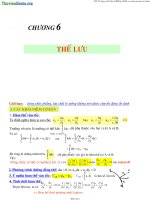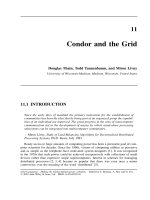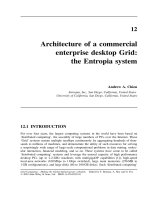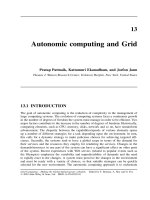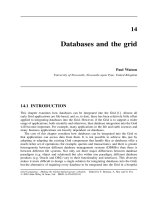Tài liệu Grid Computing P23 pdf
Bạn đang xem bản rút gọn của tài liệu. Xem và tải ngay bản đầy đủ của tài liệu tại đây (101.46 KB, 14 trang )
23
Classifying and enabling Grid
applications
Gabrielle Allen,
1
Tom Goodale,
1
Michael Russell,
1
Edward Seidel,
1
and John Shalf
2
1
Max-Planck-Institut f¨ur Gravitationsphysik, Golm, Germany,
2
Lawrence Berkeley
National Laboratory, Berkeley, California, United States
23.1 A NEW CHALLENGE FOR APPLICATION
DEVELOPERS
Scientific and engineering applications have driven the development of high-performance
computing (HPC) for several decades. Many new techniques have been developed over
the years to study increasingly complex phenomena using larger and more demanding jobs
with greater throughput, fidelity, and sophistication than ever before. Such techniques are
implemented as hardware, as software, and through algorithms, including now familiar
concepts such as vectorization, pipelining, parallel processing, locality exploitation with
memory hierarchies, cache use, and coherence.
As each innovation was introduced, at either the hardware, operating system or algo-
rithm level, new capabilities became available – but often at the price of rewriting appli-
cations. This often slowed the acceptance or widespread use of such techniques. Further,
Grid Computing – Making the Global Infrastructure a Reality. Edited by F. Berman, A. Hey and G. Fox
2003 John Wiley & Sons, Ltd ISBN: 0-470-85319-0
602
GABRIELLE ALLEN ET AL.
when some novel or especially disruptive technology was introduced (e.g. MPPs pro-
grammed using message passing) or when an important vendor disappeared (e.g. Thinking
Machines), entire codes had to be rewritten, often inducing huge overheads and painful
disruptions to users.
As application developers and users who have witnessed and experienced both the
promise and the pain of so many innovations in computer architecture, we now face
another revolution, the Grid, offering the possibility of aggregating the capabilities of
the multitude of computing resources available to us around the world. However, like all
revolutions that have preceded it, along with the fantastic promise of this new technol-
ogy, we are also seeing our troubles multiply. While the Grid provides platform-neutral
protocols for fundamental services such as job launching and security, it lacks sufficient
abstraction at the application level to accommodate the continuing evolution of individual
machines. The application developer, already burdened with keeping abreast of evolution
in computer architectures, operating systems, parallel paradigms, and compilers, must
simultaneously consider how to assemble these rapidly evolving, heterogeneous pieces,
into a useful collective computing resource atop a dynamic and rapidly evolving Grid
infrastructure.
However, despite such warnings of the challenges involved in migrating to this poten-
tially hostile new frontier, we are very optimistic. We strongly believe that the Grid can
be tamed and will enable new avenues of exploration for science and engineering, which
would remain out of reach without this new technology. With the ability to build and
deploy applications that can take advantage of the distributed resources of Grids, we will
see truly novel and very dynamic applications. Applications will use these new abilities to
acquire and release resources on demand and according to need, notify and interact with
users, acquire and interact with data, or find and interact with other Grid applications.
Such a world has the potential to fundamentally change the way scientists and engineers
think about their work. While the Grid offers the ability to attack much larger scale prob-
lems with phenomenal throughput, new algorithms will need to be developed to handle
the kinds of parallelism, memory hierarchies, processor and data distributions found on
the Grid. Although there are many new challenges in such an environment, many familiar
concepts in parallel and vector processing remain present in a Grid environment, albeit
under a new guise. Many decades-old strategies that played a role in the advancement of
HPC, will find a new life and importance when applied to the Grid.
23.2 APPLICATIONS MUST BE THE LIFEBLOOD!
Grids are being engineered and developed to be used; thus attention to application needs
is crucial if Grids are to evolve and be widely embraced by users and developers. What
must happen before this new Grid world is used effectively by the application commu-
nity? First, the underlying Grid infrastructure must mature and must be widely and stably
deployed and supported. Second, different virtual organizations must possess the appro-
priate mechanisms for both co-operating and interoperating with one another. We are
still, however, missing a crucial link: applications need to be able to take advantage of
CLASSIFYING AND ENABLING GRID APPLICATIONS
603
this infrastructure. Such applications will not appear out of thin air; they must be devel-
oped, and developed on top of an increasingly complex fabric of heterogeneous resources,
which in the Grid world may take on different incarnations day-to-day and hour-to-hour.
Programming applications to exploit such an environment without burdening users with
the true Grid complexity is a challenge indeed!
Of many problems, three major challenges emerge: (1) Enabling application develop-
ers to incorporate the abilities to harness the Grid, so that new application classes, like
those described in this chapter, can be realized; (2) Abstracting the various Grid capabil-
ities sufficiently so that they may be accessed easily from within an application, without
requiring detailed knowledge about the underlying fabric that will be found at run time;
and (3) Posing these abstractions to match application-level needs and expectations. While
current Grid abstractions cover extremely low-level capabilities such as job launching,
information services, security, and file transfer (the ‘Grid assembly language’), applica-
tions require higher-level abstractions such as checkpointing, job migration, distributed
data indices, distributed event models for interactive applications, and collaborative inter-
faces (both on-line and off-line).
In the experience of communities developing applications to harness the power of com-
puting, frameworks are an effective tool to deal with the complexity and heterogeneity
of today’s computing environment, and an important insurance policy against disruptive
changes in future technologies. A properly designed framework allows the application
developer to make use of APIs that encode simplified abstractions for commonly-used
operations such as creation of data-parallel arrays and operations, ghostzone synchroniza-
tion, I/O, reductions, and interpolations. The framework communicates directly with the
appropriate machine-specific libraries underneath and this abstraction allows the devel-
oper to have easy access to complex libraries that can differ dramatically from machine to
machine, and also provides for the relatively seamless introduction of new technologies.
Although the framework itself will need to be extended to exploit the new technology,
a well-designed framework will maintain a constant, unchanged interface to the applica-
tion developer. If this is done, the application will still be able to run, and even to take
advantage of new capabilities with little, if any, change. As we describe below, one such
framework, called Cactus [1], has been particularly successful in providing such capa-
bilities to an active astrophysics and relativity community – enabling very sophisticated
calculations to be performed on a variety of changing computer architectures over the last
few years.
The same concepts that make Cactus and other frameworks so powerful on a great
variety of machines and software infrastructures will also make them an important and
powerful methodology for harnessing the capabilities of the Grid. A Grid application
framework can enable scientists and engineers to write their applications in a way that
frees them from many details of the underlying infrastructure, while still allowing them
the power to write fundamentally new types of applications, and to exploit still newer
technologies developed in the future without disruptive application rewrites. In particular,
we discuss later an important example of an abstracted Grid development toolkit with
precisely these goals. The Grid Application Toolkit, or GAT, is being developed to enable
generic applications to run in any environment, without change to the application code
604
GABRIELLE ALLEN ET AL.
itself, to discover Grid and other services at runtier, and to enable scientists and engineers
themselves to develop their applications to fulfil this vision of the Grid of the future.
23.3 CASE STUDY: REAL-WORLD EXAMPLES WITH
THE CACTUS COMPUTATIONAL TOOLKIT
Several application domains are now exploring Grid possibilities (see, e.g. the GriPhyN,
DataGrid, and the National Virtual Observatory projects). Computational framework and
infrastructure projects such as Cactus, Triana, GrADs, NetSolve, Ninf, MetaChaos, and
others are developing the tools and programming environments to entice a wide range
of applications onto the Grid. It is crucial to learn from these early Grid experiences
with real applications. Here we discuss some concrete examples provided by one spe-
cific programming framework, Cactus, which are later generalized to more generic Grid
operations.
Cactus is a generic programming framework, particularly suited (by design) for devel-
oping and deploying large scale applications in diverse, dispersed collaborative environ-
ments. From the outset, Cactus has been developed with Grid computing very much
in mind; both the framework and the applications that run in it have been used and
extended by a number of Grid projects. Several basic tools for remote monitoring, visual-
ization, and interaction with simulations are commonly used in production simulations [2].
Successful prototype implementations of Grid scenarios, including job migration from
one Grid site to another (perhaps triggered by ‘contract violation’, meaning a process
run more slowly than contracted at one site, so another more suitable site was dis-
covered and used); task spawning, where parts of a simulation are ‘outsourced’ to a
remote resource; distributed computing with dynamic load balancing, in which multi-
ple machines are used for a large distributed simulation, while various parameters are
adjusted during execution to improve efficiency, depending on intrinsic and measured
network and machine characteristics [3, 4, 5], have all shown the potential benefits and
use of these new technologies. These specific examples are developed later into more
general concepts.
These experiments with Cactus and Grid computing are not being investigated out of
purely academic interest. Cactus users, in particular, those from one of its primary user
domains in the field of numerical relativity and astrophysics, urgently require for their
science more and larger computing resources, as well as easier and more efficient use of
these resources. To provide a concrete example of this need, numerical relativists currently
want to perform large-scale simulations of the spiraling coalescence of two black holes, a
problem of particular importance for interpreting the gravitational wave signatures that will
soon be seen by new laser interferometric detectors around the world. Although they have
access to the largest computing resources in the academic community, no single machine
can supply the resolution needed for the sort of high-accuracy simulations necessary
to gain insight into the physical systems. Further, with limited computing cycles from
several different sites, the physicists have to work daily in totally different environments,
working around the different queue limitations, and juggling their joint resources for best
effect.
CLASSIFYING AND ENABLING GRID APPLICATIONS
605
Just considering the execution of a single one of their large-scale simulations shows that
a functioning Grid environment implementing robust versions of our prototypes would
provide large benefits: appropriate initial parameters for the black hole simulations are
usually determined from a large number of smaller scale test runs, which could be automat-
ically staged to appropriate resources (task farming for parameter surveys). An intelligent
module could then interpret the collected results to determine the optimal parameters
for the real simulation. This high-resolution simulation could be automatically staged
across suitable multiple machines (resource brokering and distributed computing). As it
runs, independent, yet computationally expensive, tasks could be separated and moved to
cheaper machines (task spawning). During the big simulation, additional lower resolution
parameter surveys could be farmed to determine the necessary changes to parameters gov-
erning the simulation, parameter steering, providing the mechanism for communicating
these changes back to the main simulation. Since these long-running simulations usually
require run times longer than queue times, the entire simulation could be automatically
moved to new resources when needed, or when more appropriate machines are located
(job migration). Throughout, the physicists would monitor, interact with, and visualize
the simulation.
Implementing such composite scenarios involves many different underlying Grid oper-
ations, each of which must function robustly, interoperating to good effect with many
other components. The potential complexity of such systems motivates us to step back and
consider more general ways to describe and deliver these requirements and capabilities.
23.4 STEPPING BACK: A SIMPLE
MOTIVATION-BASED TAXONOMY
FOR GRID APPLICATIONS
The Grid is becoming progressively better defined [6]. Bodies such as the Global Grid
Forum are working to refine the terminology and standards required to understand and
communicate the infrastructure and services being developed. For Grid developers to be
able to ensure that their new technologies satisfy general application needs, we need to
apply the same diligence in classifying applications; what type of applications will be
using the Grid and how will they be implemented; what kinds of Grid operations will
they require, and how will they be accessed; what limitations will be placed by security
and privacy concerns or by today’s working environments; how do application developers
and users want to use the Grid, and what new possibilities do they see.
In the following sections we make a first pass at categorizing the kinds of applications
we envisage wanting to run on Grids and the kinds of operations we will need to be
available to enable our scenarios.
23.4.1 Generic types of Grid applications
There are many ways to classify Grid applications. Our taxonomy divides them here
into categories based on their primary driving reasons for using the Grid. Current Grid
